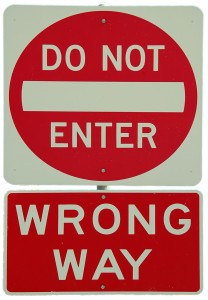Kevin Balke turned his SUV southeastward, checked his instruments and confirmed he was ready. Nearly a mile of concrete stood before him with plenty of room to run, but he wouldn’t need all of it to prove his point – he’d be going the wrong way in no time.
The Houston Chronicle reports accelerating past a pole jutting from an electrical box – just like the ones that line every Texas highway – it took only a few seconds for the tablet mounted to the dash of Balke’s Ford Explorer to explode with the flashing warning: Wrong Way, styled just like the signs common on roads, with a red background and bold letters.
“It got us,” Balke said, confirming the tablet gave him the warning he wanted to see.
Wednesday it was just a demonstration of an ongoing research project by the Texas A&M Transportation Institute and Southwest Research Institute. It will not be too many tomorrows, however, until it ends up in drivers’ dashboards as cars communicate their position and the wrong-way mistakes of drivers, to others.
During the demonstration for transportation researchers and Texas Department of Transportation engineers, a different message than the one Balke – a TTI research engineer – received flashed onto the screen of Melisa Finley’s Explorer, cruising toward Balke’s at a closed runway on A&M’s RELLIS campus. While Balke received a warning, Finley’s tablet alerted her a wrong-way driver was approaching. A tablet in a police cruiser parked nearby flashed the same warning. Inside a tent where a makeshift transportation operations center was set up, Cameron Mott, with SwRI, motioned people through what a transportation manager would see and how that information would filter to the public at large.
Researchers are moving in the right direction, developing a system that makes sure drivers who go the wrong way are easier to alert and track. The study is part of national efforts to address various parts of connected vehicle technology, considered a precursor to fully autonomous vehicles.
Connected vehicles allow for cars and trucks to communicate details amongst themselves and the road, in hopes of giving drivers better information so they can react accordingly. In some cases, connected vehicle research builds on existing information, such as traffic data that Houston – TranStar or Waze pushes to drivers via smartphone. Connected vehicles in some cases just put the phone in the vehicle’s dashboard on short-length capabilities so the cars around each other know their speed and location. That way, if one blows a tire or a car suddenly enters the freeway up an exit ramp, the rest are soon alerted.
“We are going to have more and more cars on the roadway that can talk,” said Finley, the lead researcher on the wrong way detection system for TTI.
In a joint partnership with the Texas Department of Transportation, the two research centers – A&M’s based in College Station and Southwest in San Antonio – focused on wrong-way driving, which has been an issue on Texas roads, including many in Houston. Annually, the state averages 237 crashes related to wrong-way drivers, based on 2010-2014 traffic counts. More than half of those resulted in a fatality crash. Researchers said most of those crashes occur at night, with alcohol impairment often a factor. On freeways, the most common way for someone to drive the wrong direction is to enter the freeway on an off-ramp.
Already, Texas has some exit ramps equipped with warning lights for wrong way drivers, particularly in the San Antonio area. Harris County Toll Road Authority has extensively lined tollway exits with warning lights. TxDOT has used the system at ramps with a history of wrong-way drivers in the Houston area, while TranStar has relayed information using the message signs along freeways.
In wrong-way incidents, however, seconds can make a difference, so the sooner you get the driver’s attention and the attention of those traveling nearby, the better.
“We’d like to warn them in their vehicle, so they turn around immediately,” Finley said.
Connecting the cars and the road requires a combination of technologies. Radar and cameras detect vehicles moving the wrong direction at the exit ramp, then that warning is relayed via low-range radio signal. The car moving the wrong direction – which is constantly alerting its position – is sent a warning. Other cars in the area are sent alerts, while the traffic operations center -in Houston’s case, TranStar – would see the incident flash as a warning.
To get the full effect of connected cars, researchers concede all the cars must be connected and the road equipped. Both of those are happening at a fast pace, said Hassan Charara, a software developer with TTI.
“In the short term, the car will be built with it,” Charara said. “It will be the standard.”
After-market devices would allow older models to operate on the connected systems.
Devices would be included along roads, meanwhile, during routine maintenance or reconstruction.
Connected cars, just as some of Houston’s Bluetooth-based traffic detection, are developed to provide anonymity to drivers, said Cameron Mott, senior connected vehicles and cybersecurity research analyst at Southwest Research Institute.
“This is traceable to a behavior that is a danger to others,” Mott said, noting the system only identifies a car when it does something against the norm. “It is just as anonymous as someone on the side of the road looking at these vehicles.”
Was this article valuable?
Here are more articles you may enjoy.

 Musk’s xAI Faces California AG Probe Over Grok Sexual Images
Musk’s xAI Faces California AG Probe Over Grok Sexual Images  Singer’s Elliott Sued by PE Firm in Escalating Fight Over Money
Singer’s Elliott Sued by PE Firm in Escalating Fight Over Money  NYC Sues Delivery App Over Lost Pay in New Mamdani Crackdown
NYC Sues Delivery App Over Lost Pay in New Mamdani Crackdown  Tesla, EEOC Plan Talks to Settle Factory Racism Suit
Tesla, EEOC Plan Talks to Settle Factory Racism Suit 